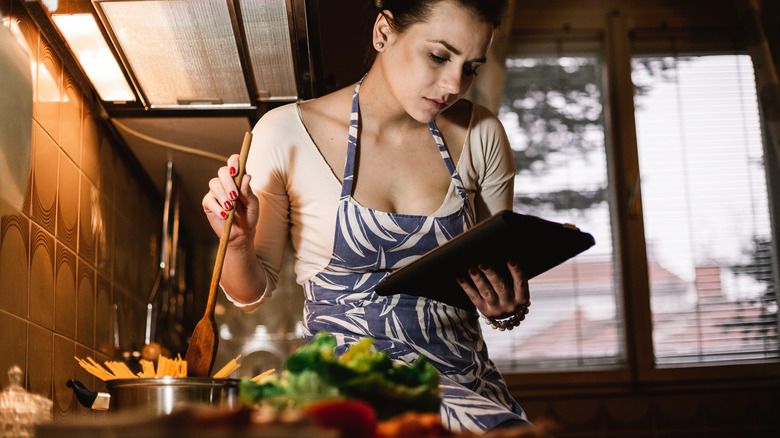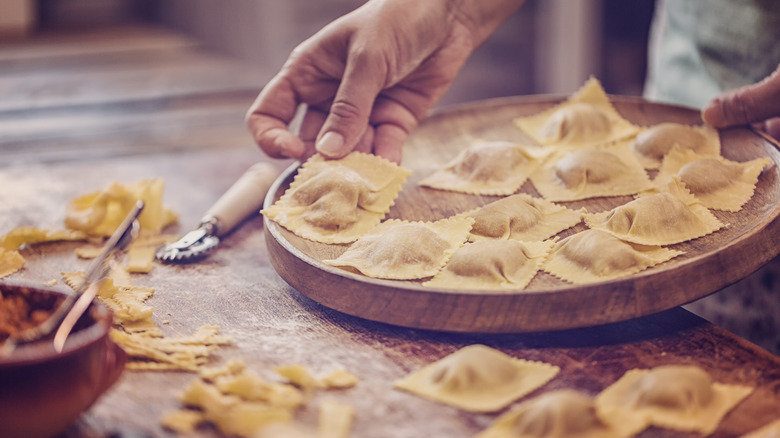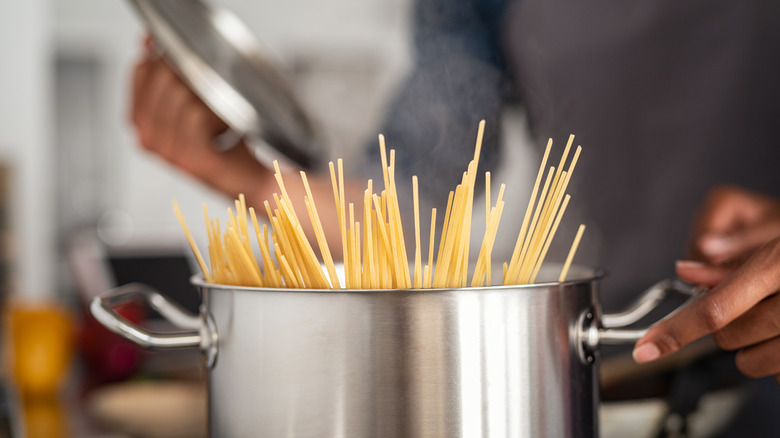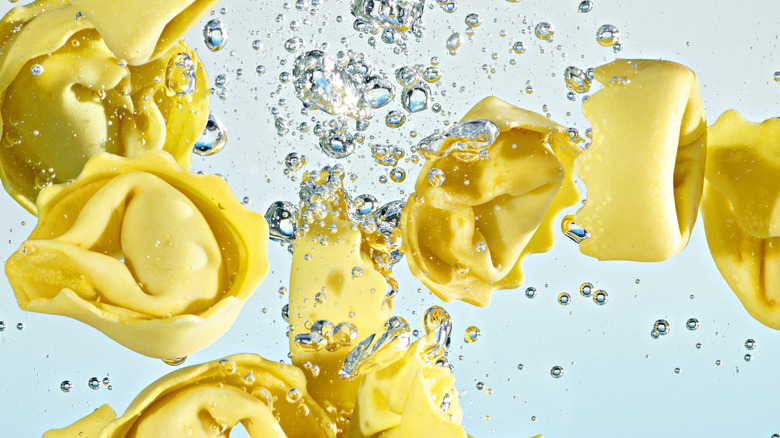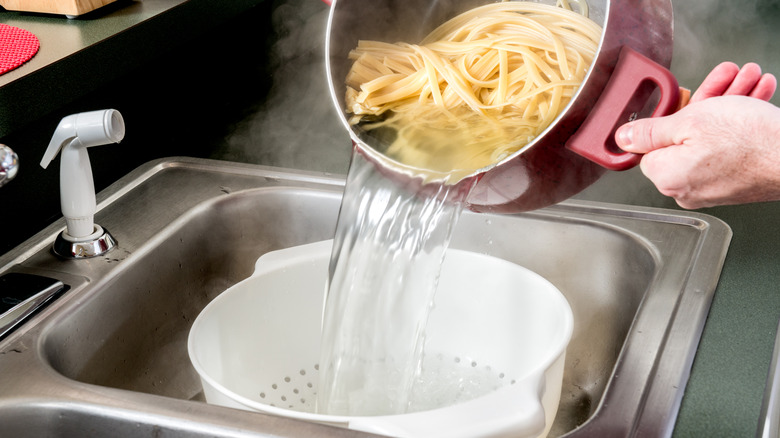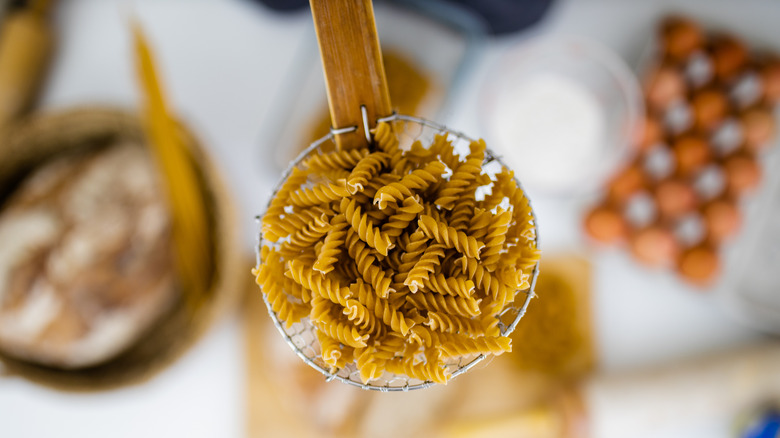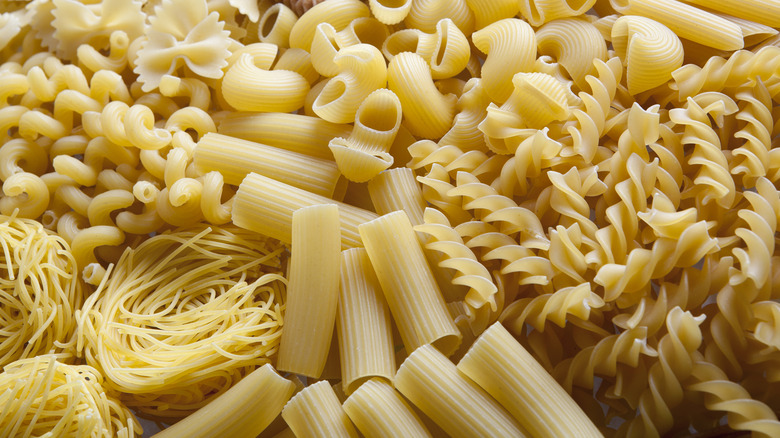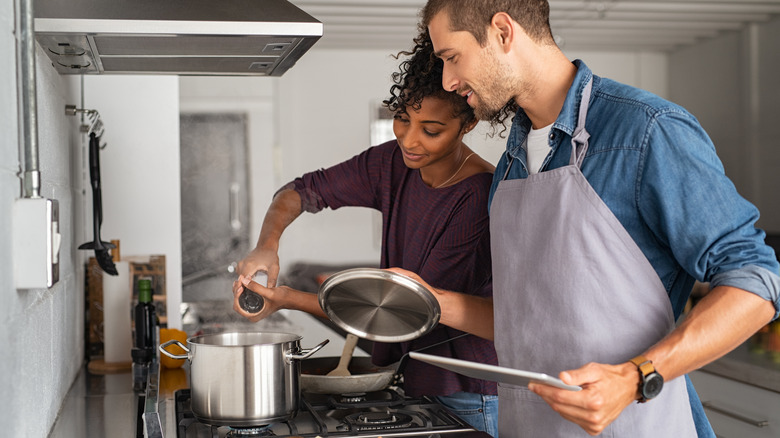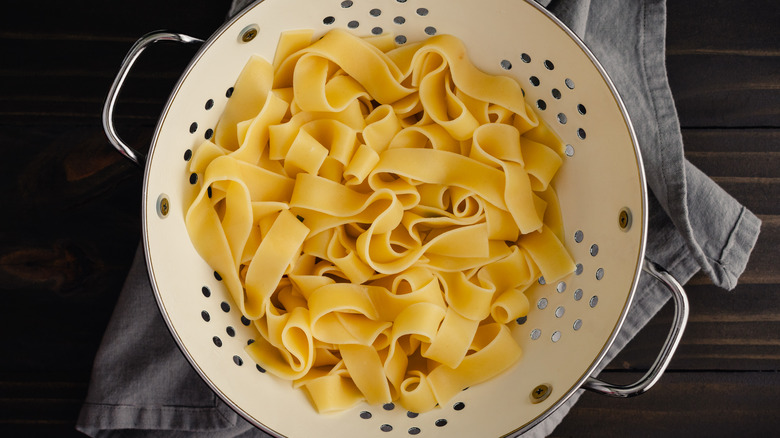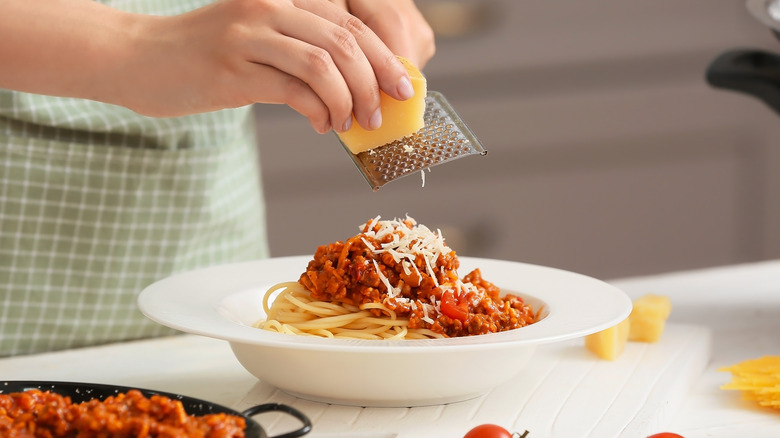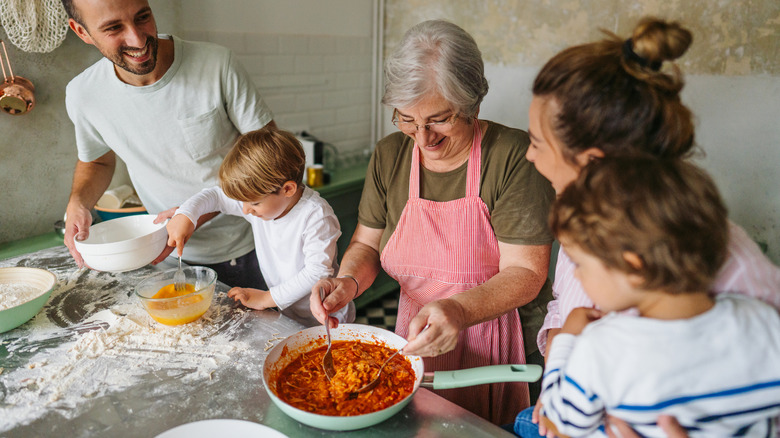13 Mistakes Everyone Makes When Cooking Italian Pasta Dishes, According To Chef Tim Hollingsworth
Break out your best bucatini. The days of slimy strozzapreti, mushy macaroni, and flavorless farfalle are finito! Cook your pasta like a pro by basking in the visionary glow of award-winning chef Tim Hollingsworth, restaurateur and owner of Otium restaurant in downtown Los Angeles.
Holy cacio e pepe — he knows our No. 1 carb like the back of his hand. Responsible for the constant rotation of inspired pasta dishes on the menu at Otium — think English pea agnolotti with Meyer lemon, and spinach bucatini with confit egg yolk — Hollingsworth has been busy reimagining the art of the elevated dish ever since his stint as Chef de Cuisine at The French Laundry. (Three Michelin stars, maybe you've heard of it?) Hollingsworth's culinary solo album had famed restaurant critic Jonathan Gold calling Otium, "L.A.'s most ambitious restaurant in years," when it opened in 2015. Somehow, the James Beard Foundation's former Rising Star Chef of the Year Award-winner made time for an exclusive interview with us.
For all the fanfare, though, Hollingsworth appears to still really enjoy eating simple, well-prepared food with the people he loves most. (Isn't that what Italian food is all about?) Boxed noodles and pasta machines, to pots, spiders, and all the salted water you can handle, here's how you really earn that cavatelli clout. From now on, it's only spaghetti — no regretti.
You got too complicated with the pasta recipe
It's tempting to want to impress your dinner guests with a pasta-based performance piece. (Googling dry ice pellets, French cloches, and opera.) But if you really want to please a crowd, don't go nuts with a complicated recipe. When it comes to Italian, simple is better. Especially for newbies.
"For rookies, I generally suggest spaghetti aglio e olio with garlic and olive oil, because it's a simple pasta and you more than likely have these ingredients in your home already," Hollingsworth advises, as we mentally scan our home pantry like The Terminator looking for chili flakes. "Even though the dish is simple, it delivers the essence of a great pasta dish — which is that it's homey and the ingredients shine through."
Originating in Southern Italy, Spaghetti Aglio e Olio was once a staple for families with humble means. Want another simple, but knock-your-socks-off idea? We've got a pasta al limone recipe that's pretty much summer on a plate. Mangia!
You didn't shop for quality dry pasta
Slow your roll, Grocery Kartz. Don't blow off the store-bought boxed brands you see on the shelves. If you're wondering how to cook dried pasta, the first step is knowing what to look for on the back of the box. Skip past the fancy ingredients (Who among us doesn't import fresh spring water from the mountains of Italy?), and read up on the cooking instructions. As chef Tim Hollingsworth assures us, "There are definitely some high quality pastas out there." Here's how to find them.
"Typically, the longer the cook time means the higher the quality pasta, in my personal experience," he says. "The higher cook time references the few ingredients used in the making of the pasta and the process in which it is dried."
Not one to miss out on a challenge, we road tested this theory with two brand name boxed pastas — and these shall remain anonymous. Box A featured one ingredient (Organic durum wheat semolina grown in Italy), with a cook time of 12 minutes. Box B listed a few more ingredients (Durum wheat, semolina, niacin, ferrous sulfate, thiamin, riboflavin, and folic acid), with a cook time of nine minutes. We'll take Box A.
You don't need a pasta maker to make great pasta
With the right tools and tricks, you can make $4 spaghetti taste like $24 spaghetti. And you don't need to invest in a pasta maker to do it. Even in Italy — in certain regions — you'll find dishes that are traditionally made with dried pasta.
Chef Tim Hollingsworth explains, "Having dried pasta on hand is always a great way to make something out of nothing. For example, if you have dried pasta in your pantry, you can find what else is around you in your fridge and whip up a great dish."
But if you're feeling the urge to try your hand at making fresh pasta at home, you must freely answer the call of the pillowy ravioli. "There is definitely a benefit and an enjoyment in making your own fresh pasta," Hollingsworth notes, adding that you still don't need to shell out for the latest pasta maker 3000. "You can, of course, make your own pasta for a fun weekend project or a special occasion, but you don't need a machine to do that." (Here's how you make pasta from scratch.)
You didn't use a big enough pot to cook your pasta
The pasta pot rule of thumb isn't just about the folklore around not breaking your noodles. (Still, who would want to anger the garganelli gods?) Otium restaurant owner Tim Hollingsworth explains that it's intended to be a quick visual cue for home cooks. He also offers us an off-ramp should we have, say, no stock pot in the house.
"You can definitely cook spaghetti in a saucepan. That being said, the pan needs to be large enough so it has the appropriate amount of pasta to water ratio." Going by the no pasta-breaking method, you can easily see that if your pasta's hanging out over the edge of the pot, it's not cooking in the water, and you're gonna need a bigger pot. "I believe the Italians would say — it's a sin to break your spaghetti," Hollingsworth says. "Avoid that by opting for the correct size cooking vessel!"
No suitable pot? No problem. Skip the water altogether and boil your pasta right in the sauce.
You're cooking pasta with warm water, not cold
We fully admit to filling a pot with warm water, in order to make it boil faster. This, however, is the opposite of pasta-cooking science, and we're never doing it again because chef Tim Hollingsworth has shown us the light.
"Start with cold filtered water," he explains. (Sorry, just had to pause there because we fell off our chairs. Cold?!) "Cover your pot and bring the water to a boil. Once boiling, you can remove the lid and add salt to the water. When the salted water returns to a boil, you then add your pasta."
While some other chefs may start pasta in cold water, Hollingsworth lets the pot come to a boil before adding the noods. And, despite what you may have googled, he explains that, "Cold water boils faster than warm water." He also offers a tip on salting the water, adding, "I also season it after it boils because if you season your pasta water too early and it starts to boil over a little, then you get a salt water residue on your stove and pan ... and no one wants that." It's like he can see into our minds.
You dumped your pasta water
If you haven't heard, let us introduce you to the cereal milk of dinnertime: Pasta water. It is Italian pasta dish perfection. And it's right at your fingertips, ready to go straight down the drain before you know it. What do you do? Reserve it. When do you do it? Now.
"Pasta has a lot of starch, so when you're boiling it in water, there is some starch in that water as well," chef Tim Hollingsworth notes. (You had us at starch, Tim. Please continue ... ) "It's also seasoned, so if you need to adjust your sauce in any way, it's nice to have some of that seasoned pasta water to use instead of getting water from your tap." It makes a big splash in just about any dish, but it's not a total disaster if you forgot to reserve this liquid gold. Here's what to do when you accidentally dump your pasta water.
Hollingsworth cites the use of pasta water in dishes like cacio e pepe where that seasoned water really shines. He explains, "It is really just about the pasta, the black pepper, and the parm along with the water and the salt. You're not adding stock, or cream, or butter to this dish — so adding in some starchy pasta water is what helps you get the emulsification with the cheese."
You overcooked your pasta
Like waiting for the fleeting moment an avocado becomes ripe, pasta cooking requires split second decision making. Too long in the water, and it's mushy. Too short of a boil, and it's raw. Just like Goldilocks, that "just right" doneness is entirely up to you. But Tim Hollingsworth, chef and owner of Otium, offers some pointers to help you nail your favorite texture.
"If it's dry pasta, you want to cook it until it has just a little bite to it," Hollingsworth advises, admitting that he likes his pasta with bite, but not crunch. "With fresh pasta, it cooks really fast — so it's important to not overcook it. You want it to be tender but not falling apart. A lot of the time with fresh pasta, I'll dry it out a little before I cook it. (That could be for a few hours or even overnight — and that helps keep the structure with the quick cook time.)"
(Currently hanging fresh noodles on the laundry line for tomorrow.) Also thinking of making a Roman-style spaghetti alla carbonara with guanciale, which is totally fun to say. And even better to eat.
You overlooked essential pasta-making tools
Last call. All aboard the pasta spider train! You know those tools that pasta lovers can't stop talking about? It turns out they're more than just a hashtag trend. Let's take it to the expert.
"I use a spider strainer to remove pasta from the pasta water," says chef Tim Hollingsworth. Other than totally giving authentic Italian nonna, it's actually quite practical. "It gives me the ability to take the pasta out of the water without draining all of the water with it." Because we are now officially obsessed with that stuff.
Hollingsworth also has a go-to utensil when it comes to plating with precision. He reveals, "I use a meat fork when I'm making longer noodles, so that I can twirl it into a nice presentable shape for the bowl." (Meat fork. Add to cart.) But he doesn't forget the final touches, either, adding, "I also use a microplane for grating cheese over the top of pasta because with a harder, drier cheese like Parmesan or Pecorino Romano, it grates better and easier on a microplane."
You didn't choose the right pasta shape for the dish
Maybe you're team macaroni-everything. Or you pick noodles based on their fun-to-chew shapes (Holla, cavatappi). If that's you, there's a chance you now know that Italian pasta dishes rely on the right pasta shape for the sauce.
"Different shapes of different pastas were specifically designed for how pasta is served," Tim Hollingsworth, Otium chef, explains. "If you were going to take a classic dish like spaghetti bolognese (That is a longer noodle), you twirl it over top with the sauce. Then you have something like tortellini, which picks up broth nicely — so that's the shape you want when you make something with a broth or a consume. Agnolotti has a pocket that picks up a nice butter sauce, so if you're making something with a quick emulsification with butter, use an agnolotti shape."
But it's not a lost cause if you've got an orphan box of pasta in the pantry without an idea for a meal. Hollingsworth says, "I would suggest doing research to figure out what type of traditional dishes are served with that shape and mimic something in that style when you're making pasta at home."
You forgot to season along the way
Just seasoning with a flurry of sea salt flakes the moment you plate your pasta? You could be missing out on some phenomenal flavor earlier in the cooking process. Chef Tim Hollingsworth has us reaching for the salt pig, explaining, "Whenever you cook, you want to make sure you're seasoning along the way as a general rule — not just salt at the beginning or salt at the end."
Even if you went gangbusters on a jazzy sauce, it won't make up for plain-Jane pasta. "If you were to put your pasta into a sauce that is aggressively or well-seasoned, but you didn't cook your pasta in salted water, the dish may be seasoned but the pasta will be bland," notes Hollingsworth. "I think this is especially important when making something like risotto. If you don't season the rice while it's cooking, no matter what you put in, the rice will be bland — so you want to be sure to season along the way so the liquid that is being absorbed by the rice while cooking is seasoned and the rice gets seasoned as a result."
There's a time and a place for plain pasta with butter. That time was third grade. As Hollingsworth tells it, "You season everything."
You didn't serve your pasta immediately
Ever tried to untangle the rat king that is sticky, coagulated pasta that's been hanging out in a strainer too long? Timing your pasta to dinner-o'clock is a fine art that's helpful to master. Here's what chef Tim Hollingsworth has to say about it.
"Pasta should be served immediately after it's done cooking," he warns. "As a general rule, it's something you want to cook last-minute and serve immediately." Still, it's a different story with cold dishes, like pasta salad. "If you're making a cold pasta dish, then I would run it under cold water to stop the cooking process, and then I would make sure that all the water is drained off and drizzle it with a little oil so it doesn't stick together." (We even have a hack to quickly cool your pasta salad.)
Still, as long as you like your pasta piping hot with a side of not forming a free-standing sculpture of itself, cook it, plate it, and dig in right away. (And don't be too hard on yourself, it still counts if you're sticking a fork straight into the pot.)
You're afraid to try something new with your pasta recipes
We've all gotten to that point where we've exhausted any and all ways to liven up plain spaghetti. But Tim Hollingsworth of Otium fame encourages anyone who's maxed out on ravioli lasagna every Tuesday to find new inspiration in tried and true classics.
"When I'm creating dishes for Otium, I think it's fun to view pasta as a vehicle," he says. "At home, I'll even take leftover birria and cook it with a noodle or pasta to take something I've already bought or made (leftovers) and turn it into a different dish so that I can eat it again but in a completely different way." For the record, we'll take a bowl of that, and another one for the road.
Hollingsworth also serves up this method at his restaurant, to hearty reception. "We have an English Pea Agnolotti on our new spring menu, which is my play on peas and burrata on toast, but served in a way that uses pasta as the main starch (And nods to the feel of toast with sourdough croutons)." Inspiration like this means basic mac and cheese night is about to get a glow-up.
You forgot that Italian pasta is meant to be shared
There's something about Italian cooking that begs to be shared. And while we stand by a comforting bowl of pasta in bed with a good Netflix series, we also love gathering around a table with friends and family, telling good stories, and enjoying a beautiful meal. Having spent decades in the restaurant business, chef Tim Hollingsworth has built his career on fine-tuning the cherished act of sharing a meal together.
"My dream pasta scenario would be sharing our Otium Spinach Bucatini with my mom," Hollingsworth revealed, when we asked him to give us the rundown on his ultimate meal. "My mom has dementia, so the thought of being able to sit down with her and have a conversation about this dish is really meaningful to me.
"I would get to explain to her my interpretation of a classic pasta dish — in this case, carbonara — and the thought process behind it," he told us. "I love this dish and was inspired by the flavor combination, and wanted to recreate it in a fun way (With the egg yolk breaking, a depth of flavor from the clams and bacon, and the fun green pop from the spinach). It's my re-interpretation of a classic dish where I get to have fun with something familiar."
Want more recipe ideas, inspiration, and expert advice? Catch Hollingsworth at the judges' table on Season 3 of The Great American Recipe, premiering June 17, 2024 on PBS.


